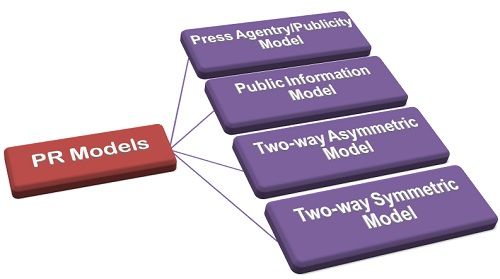Definition: The Public Relations or PR helps in shaping the image of the organization with its prospective customers in such a way that a favorable response is created.
Models of Public Relations
When we talk about the models of public relations, the only names that come to the mind is of Grunig and Hunt, who have identified four models of public relations, all of which to some extent are still prevalent in the current market scenario. These models are:
- Press Agentry/ Publicity Model: The press agentry model is characterized by the propaganda, wherein the press agents do not lay emphasis on research and surveys just want to manipulate the behavior of the target audience. Here, the public relations experts enhances the image of the organization among its stakeholders Viz. Customers, employees, government, suppliers and others who are directly or indirectly associated with the company through manipulation.
The Press Agentry/ Publicity model is also called as P.T. Barnum model. It is a one-way form of communication wherein the information is passed from the sender to the receiver without giving much consideration to the opinions of the receiver. Thus, the companies hire the PR experts to send out the strongly positive message about the company and its offerings and create a favorable image in the minds of customers through arguments and reasoning.
- Public Information Model: This is yet another one-way form of communication method wherein the PR expert shares the meaningful information about the organization and its offerings to the prospective audiences. Here also, the research and survey are not conducted to ascertain the efficiency of the message content and its effectiveness on the customers.
The purpose of this model is to educate the customers about the organization and its issues and lay much more emphasis on truthfulness than in the press agentry. Here, the PR experts rely greatly on the press release, video release, company brochures, newsletters, magazines, etc. to reach the prospective customers at regular intervals for positioning the brand image in their minds.
- Two-way Asymmetric Model: This model is developed by Edward. L. Bernays. As the name suggests, this model supports the two-way communication between the sender and the receiver, but however the communication is not balanced. This is because the PR experts position the image of the organization and a brand in the minds of the customer through manipulation and forces them to behave in a manner as expected by them. Thus, the objective of this method is to understand the psychology of the customers and manipulate it accordingly so as to get the favorable reactions.
- Two-way Symmetric Model: This is the ideal model of public relations wherein the free flow of information between the organization and its stakeholders is facilitated. Here, the emphasis is greatly laid on building understanding between the organization and its public and the conflicts are resolved through discussion and communication.
Thus, an organization should share a true and meaningful information with its public and must employ effective quantitative analysis methods to ascertain the effectiveness of the message content and the customer’s response towards it.


Etenesh says
It’s an interesting work.
Makaveli says
Wow
Samson says
That’s great job, effective communication is key among all the stakeholders in order to achieve company set goals and maintain good corporate image.
Lilly Solace says
Wow a very concise work 👍